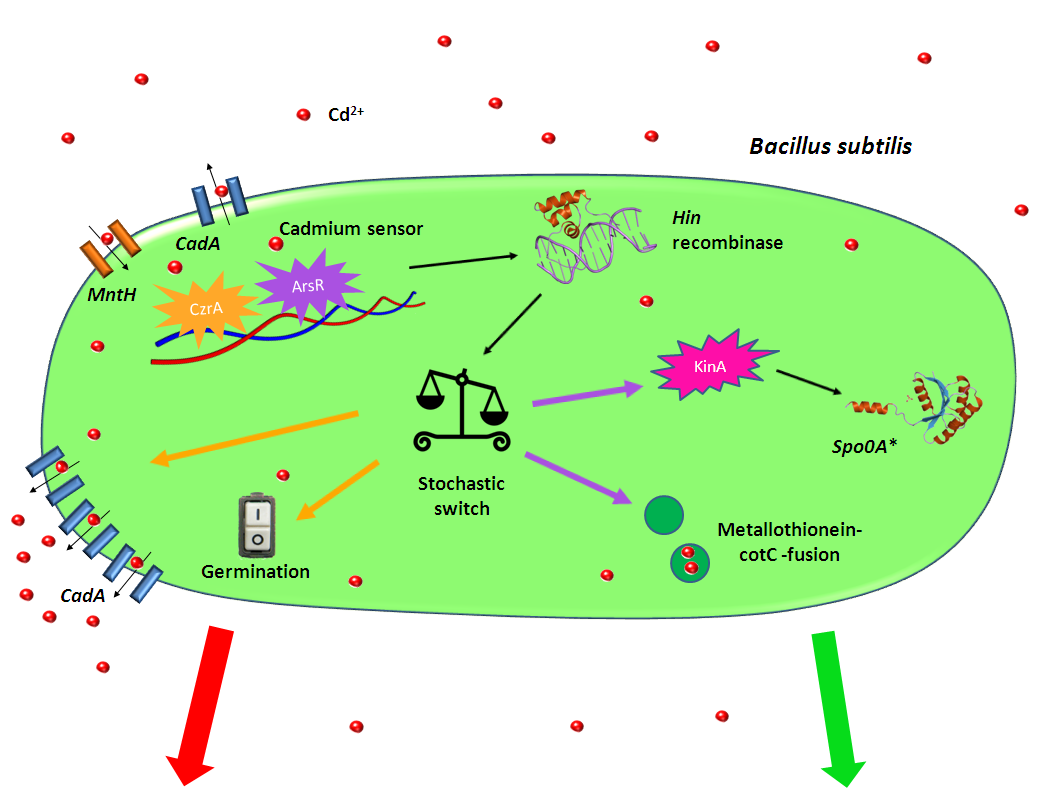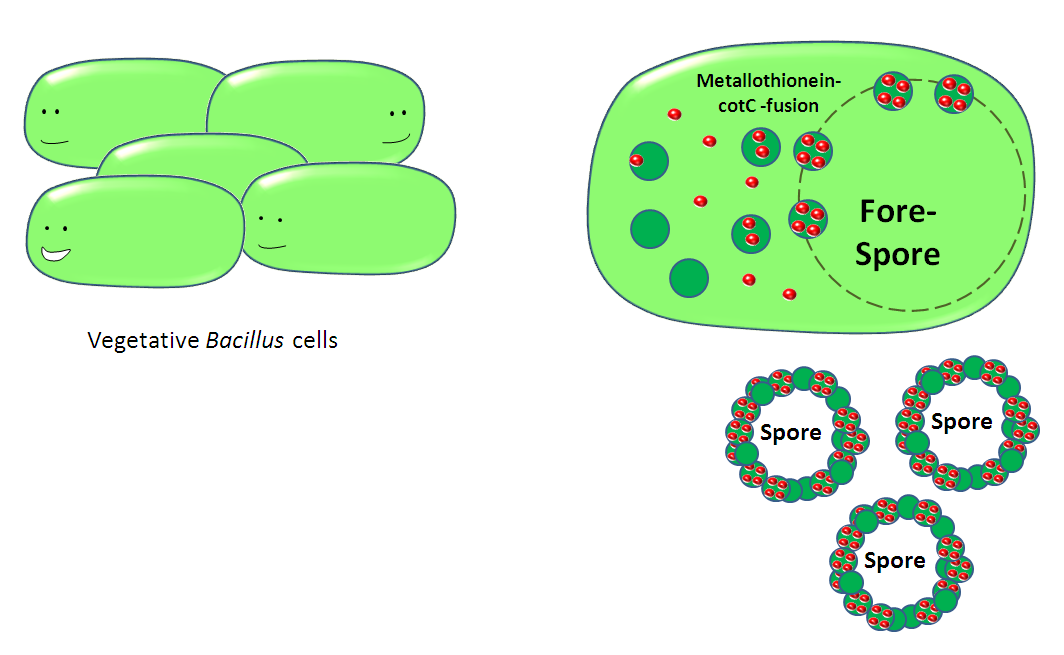Team:Newcastle
From 2009.igem.org
(→Population Dynamics) |
(→=Stochastic switch) |
||
| Line 27: | Line 27: | ||
As well as sensing cadmium we plan to engineer our bacteria’s normal population dynamics, by nudging the natural stochastic sporulation decision in favour of higher sporulation rates, to account for the spores that will be lost as metal containers. Our population model simulates whole cell populations using inputs from single cellular models and will be used to determine the required increase in sporulation rate. | As well as sensing cadmium we plan to engineer our bacteria’s normal population dynamics, by nudging the natural stochastic sporulation decision in favour of higher sporulation rates, to account for the spores that will be lost as metal containers. Our population model simulates whole cell populations using inputs from single cellular models and will be used to determine the required increase in sporulation rate. | ||
| - | + | =Stochastic switch= | |
| - | We will also design our own stochastic switch, which will be | + | We will also design our own stochastic switch, which will be used to make the cell's decision to become a metal container or not. This switch will be regulated by an invertible segment of DNA using the hin/hix system [3]. We favoured the use of an invertable DNA segment since the choice will be heritable and maintain its expression inside a spore. Our artificial stochastic switch will be a ‘biased heads or tails’ which we can control. This stochastic switch will control expression of the genes which switch on our ‘metal sponge’ or will direct the cell to a wild-type lifestyle. |
== Metal Containers == | == Metal Containers == | ||
| - | To make our spores metal containers we will be using the metallothionein protein | + | To make our spores metal containers we will be using the metallothionein protein SmtA which is a relatively small cysteine rich protein known to ‘soak up’ metals such as cadmium [4]. We will guide this protein to the spore whilst sporulating by creating a fusion with the spore coat protein CotC, which will coat the spore in cadmium bound metallothionein [5]. |
Finally, to ensure that metal containing spores will not germinate again, releasing their bound cadmium, we will ‘knock-out’ important germination genes using our invertible sequence system. | Finally, to ensure that metal containing spores will not germinate again, releasing their bound cadmium, we will ‘knock-out’ important germination genes using our invertible sequence system. | ||
Revision as of 19:55, 21 October 2009
In 2009 the Newcastle team are tackling environmental issues using Bacillus subtilis. We are a team of eight with wide ranging backgrounds in the fields of Bioinformatics, Computing Science, Chemical Engineering, Genetics and Medical Sciences. This is Newcastle's second year in the iGEM competition; last year our team designed BugBuster, which achieved a Gold Medal.
Project Description
Cadmium contamination can be a serious problem in countries where polluting industries are located close to agricultural sites. Our team developed a design to address this problem using the resiliant spore-forming bacterium Bacillus subtilis. We engineered B. subtilis to sense and sequester cadmium from the environment into metallothionein containing spores, rendering it bio-unavailable. Germination of the spores can be disabled, making retrieval of the cadmium unnecessary since they can persist intact for thousands of years. We computationally simulated the life cycles of individual cells and entire cell populations, to estimate the parameter values necessary to maintain sustainable populations of sporulating, germinating and vegetative cells. Our design required us to engineer stochastic differentiation processes at a single cell level. A sporulation rate tuner was developed and we also engineered a tuneable stochastic invertase switch to stochastically control cell differention and fate.
The following diagram gives an overview of our design...


Cadmium Sensing
Our design allows bacteria to intake cadmium through the manganese channel MntH, as cadmium also leaks through these channels in addition to other metals [1]. The metal sensing proteins we intend to use are CzrA and ArsR which both bind cadmium as well as zinc cobalt and nickel, and arsenic, silver and copper respectively [2]. These proteins are repressor proteins which also bind DNA preventing transcription of downstream CDS. The repressor proteins however release the DNA to preferentially bind cadmium [2] allowing transcription to occur allowing selective sensing of cadmium in the form of a logic AND gate.
Population Dynamics
As well as sensing cadmium we plan to engineer our bacteria’s normal population dynamics, by nudging the natural stochastic sporulation decision in favour of higher sporulation rates, to account for the spores that will be lost as metal containers. Our population model simulates whole cell populations using inputs from single cellular models and will be used to determine the required increase in sporulation rate.
Stochastic switch
We will also design our own stochastic switch, which will be used to make the cell's decision to become a metal container or not. This switch will be regulated by an invertible segment of DNA using the hin/hix system [3]. We favoured the use of an invertable DNA segment since the choice will be heritable and maintain its expression inside a spore. Our artificial stochastic switch will be a ‘biased heads or tails’ which we can control. This stochastic switch will control expression of the genes which switch on our ‘metal sponge’ or will direct the cell to a wild-type lifestyle.
Metal Containers
To make our spores metal containers we will be using the metallothionein protein SmtA which is a relatively small cysteine rich protein known to ‘soak up’ metals such as cadmium [4]. We will guide this protein to the spore whilst sporulating by creating a fusion with the spore coat protein CotC, which will coat the spore in cadmium bound metallothionein [5]. Finally, to ensure that metal containing spores will not germinate again, releasing their bound cadmium, we will ‘knock-out’ important germination genes using our invertible sequence system.
Novelty
Our design has many components which we believe are novel, such as our control over the sporulation cycle, and our synthetic stochastic switch, both systems we believe are reusable concepts within synthetic biology.
References
- Que, Q. and J.D. Helmann, Manganese homestasis in Bacillus subtilis is regulated by MntR, a bifunctional regulator related to the diphtheria toxin repressor family of proteins. Molecular Microbiology, 2000. 35(6): p. 1454-1468.
- Harvie, D.R., et al., Predicting metals sensed by ArsR-SmtB repressors: Allosteric interference by a non-effector metal. Molecular Microbiology, 2006. 59(4): p. 1341-1356.
- Haynes, K.A., et al., Engineering bacteria to solve the Burnt Pancake Problem. Journal of Biological Engineering, 2008. 2.
- Blindauer, C.A., et al., Multiple bacteria encode metallothioneins and SmtA-like zinc fingers. Molecular Microbiology, 2002. 45(5): p. 1421-1432.
- Mauriello, E.M.F., et al., Display of heterologous antigens on the Bacillus subtilis spore coat using CotC as a fusion partner. Vaccine, 2004. 22(9-10): p. 1177-1187.
External links
- [http://www.ncl.ac.uk Newcastle University]
News
Events
- 20 – 21 June 2009 - Europe workshop (London)
- 23 – 24 June 2009 - UK iGEM meetup (Edinburgh)
- 23 October Practice Presentation (Newcastle)
- 23 October T-shirts are ready
- 27 October Practice Presentation (Sunderland)
- 27 October Poster is ready
- 30 October – 2 November 2009 - Jamboree (Boston)
Social Net
- Newcastle iGEM Twitter
- [http://www.facebook.com/home.php#/group.php?gid=131709337641 Newcastle on Facebook]
- [http://www.youtube.com/user/newcastle2009igem Newcastle Youtube Channel]
 "
"

